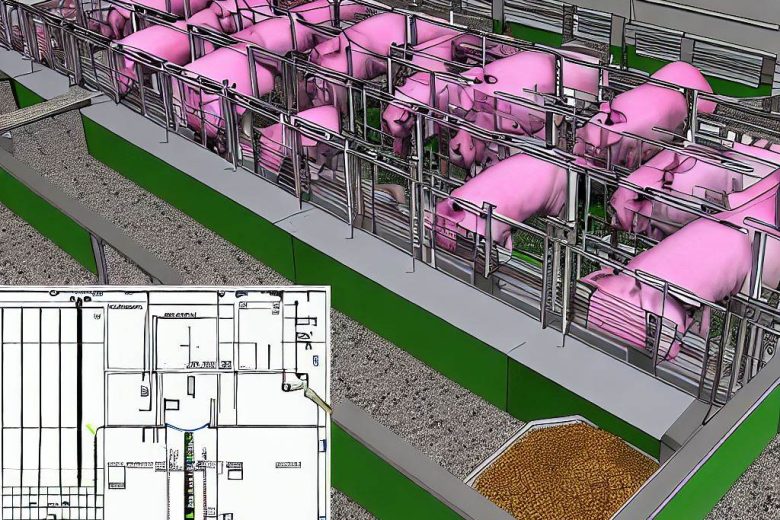If you’re considering raising pigs on your farm or homestead, building a well-designed pig pen is essential for their health and safety. A thoughtfully constructed pig pen not only provides comfortable living space for your pigs but also contributes to their overall well-being and productivity. In this article, we’ll explore 12 essential tips on how to build a pig pen successfully, ensuring your pigs thrive in a secure and pleasant environment.
12 Tips On How to Build a Pig Pen successfully
1. Selecting the Right Location
Choosing the right location for your pig pen is the first crucial step. The site should be easily accessible, well-drained, and away from potential hazards such as flood-prone areas or heavily wooded regions. Adequate space is essential for the pigs to roam freely and exercise, promoting healthy growth and reducing stress.
Read Also: 14 Cheapest Way To Build A Pig Pen
2. Choosing the Right Materials
Selecting the appropriate materials for building your pig pen is vital. Opt for sturdy, non-toxic, and weather-resistant materials that can withstand the test of time and harsh weather conditions. Additionally, ensure proper ventilation to keep the pigs comfortable and prevent respiratory issues.
3. Designing the Layout
Plan the layout of the pig pen carefully. Consider an organized and functional design that allows easy access for cleaning and feeding. Separating the sleeping area from the feeding zone helps maintain hygiene and prevents food contamination.
Read Also: [Beginners Guide] How To Build A Pig Pen For Large & Small Farms
4. Building a Solid Foundation
A stable foundation is critical for the structural integrity of the pig pen. Whether it’s a concrete base or wooden beams, a robust foundation provides stability and longevity to the pen, ensuring the safety of the pigs.
5. Constructing the Walls and Fence
Build sturdy walls and a reliable fence around the pen to keep the pigs from wandering off and to protect them from potential predators. The height of the walls and fence should be appropriate to prevent the pigs from jumping over or escaping.
Read Also: How to Build a Pig Pen with Hog Panels [Beginner’s Guide]
6. Flooring Options
The flooring material used in the pig pen should be slip-resistant, easy to clean, and comfortable for the pigs to walk on. Options like concrete, gravel, or specialized pig flooring fulfill these requirements, maintaining good hygiene in the pen.
7. Adequate Drainage System
Proper drainage is essential to prevent waterlogging in the pig pen. Design the pen with a slight slope, allowing water to flow away efficiently. Stagnant water can lead to unsanitary conditions and pose health risks to the pigs.
Read Also: 12 Requirements To Start A Poultry Farming Business
8. Providing Shelter and Shade
Shield your pigs from extreme weather conditions by providing adequate shelter and shade within the pen. This protects them from harsh sunlight, heavy rains, or cold winds, ensuring their well-being and comfort.
9. Ensuring Proper Ventilation
Proper ventilation is crucial to maintaining good air quality inside the pig pen. Install ventilation systems that allow fresh air to circulate, reducing humidity and preventing respiratory issues among the pigs.
Read Also: [DIY Guide] Poultry House Construction Guidelines Pdf
10. Hygiene and Sanitation
Regular cleaning and maintenance of the pig pen are essential to keep it hygienic and prevent the spread of diseases. Develop a cleaning schedule and dispose of waste appropriately to ensure a clean environment for the pigs.
11. Nutrition and Water Supply
Provide a well-balanced diet for your pigs and ensure access to clean and fresh water at all times. Proper nutrition is essential for their growth, health, and overall productivity.
Read Also: [Beginners Guide] How To Build A Poultry House For Layers
12. Monitoring and Healthcare
Regularly monitor the health of your pigs and schedule check-ups with a veterinarian. Vaccinations and timely medical attention help prevent and manage potential health issues.
How much space do I need for a pig pen?
The space required depends on the number and size of pigs you plan to raise. As a general rule, allocate at least 50 square feet per pig.
What materials are best for pig pen flooring?
Concrete, gravel, and specialized pig flooring are popular choices for pig pen flooring due to their durability and ease of cleaning.
Can I use recycled materials for building a pig pen?
While using recycled materials can be cost-effective, ensure they are safe, non-toxic, and provide adequate insulation and ventilation.
How often should I clean the pig pen?
Regular cleaning is essential. Daily removal of waste and thorough cleaning at least once a week is recommended.
What should I include in the pig’s diet?
A balanced diet consisting of grains, protein-rich feeds, and essential vitamins and minerals will promote the pigs’ health and growth.
Conclusion
By following these 12 tips, you can build a pig pen that provides a safe, comfortable, and healthy environment for your pigs. Investing time and effort into the design and construction process will ultimately lead to happier and more productive pigs on your farm.




